Comprehensive Analysis: The Supply Chain of Nike Corporation
VerifiedAdded on 2022/01/23
|40
|13131
|1078
Project
AI Summary
This project report provides a comprehensive analysis of Nike's supply chain management. It begins with an introduction to Nike, Inc., its product offerings, and global presence. The report delves into the company's supply chain framework and design, highlighting its outsourcing strategy, manufacturing processes, and distribution channels. Key manufacturing thrusts such as lean manufacturing and material consolidation are examined. The report analyzes Nike's distribution channels, including wholesalers, direct-to-consumer (DTC) sales, and retail partnerships. It explores the evolution of Nike's retail model, focusing on the growth of DTC sales and its impact on the company's margins and customer engagement. The report also examines Nike's approach to DTC, including its Amazon partnership, website, branded stores, social media presence, and apps. Furthermore, it touches upon Nike's sustainability initiatives, such as the Nike Considered approach. The report concludes with an overview of Nike's supply chain, providing a detailed analysis of the company's operations and strategies.
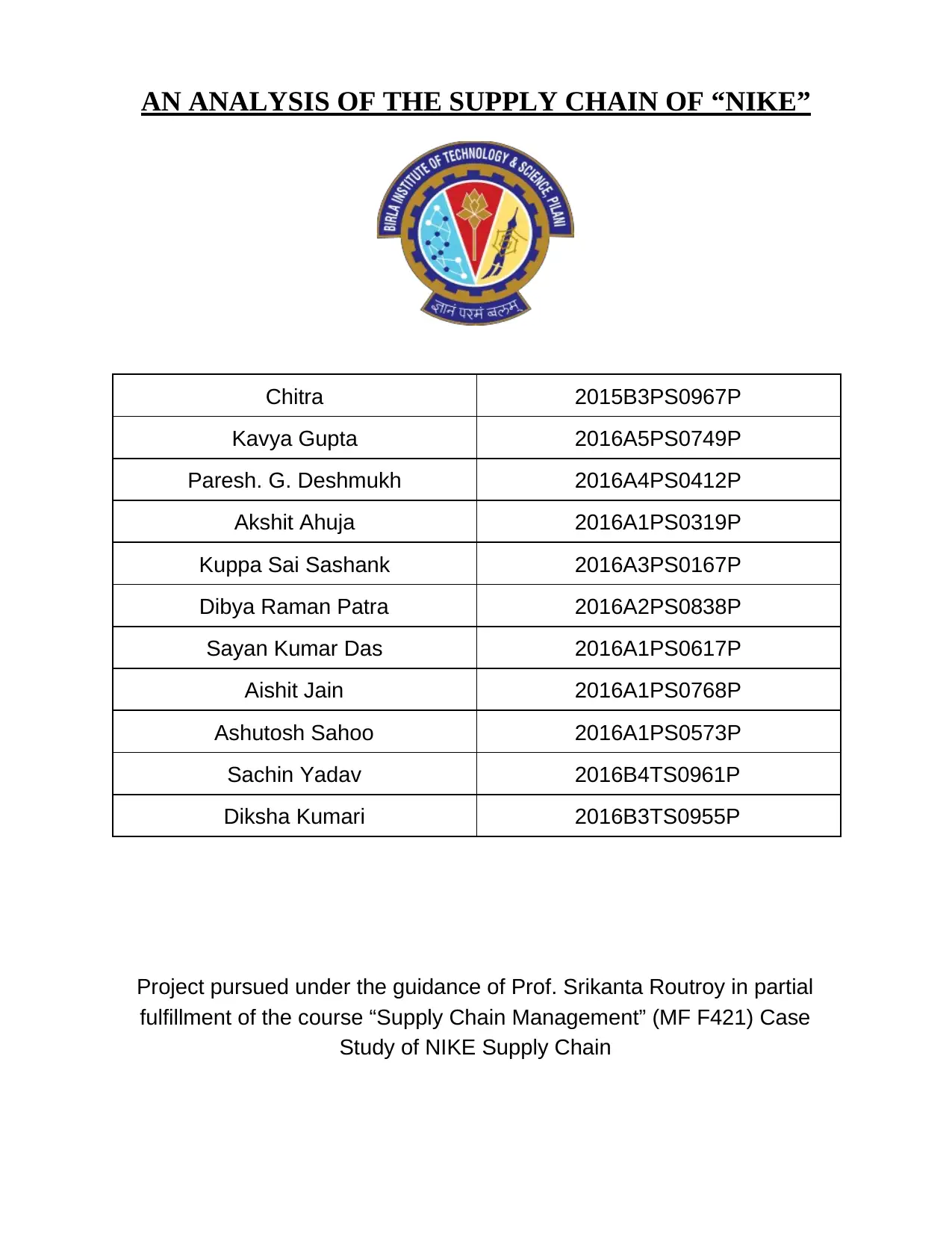
AN ANALYSIS OF THE SUPPLY CHAIN OF “NIKE”
Chitra 2015B3PS0967P
Kavya Gupta 2016A5PS0749P
Paresh. G. Deshmukh 2016A4PS0412P
Akshit Ahuja 2016A1PS0319P
Kuppa Sai Sashank 2016A3PS0167P
Dibya Raman Patra 2016A2PS0838P
Sayan Kumar Das 2016A1PS0617P
Aishit Jain 2016A1PS0768P
Ashutosh Sahoo 2016A1PS0573P
Sachin Yadav 2016B4TS0961P
Diksha Kumari 2016B3TS0955P
Project pursued under the guidance of Prof. Srikanta Routroy in partial
fulfillment of the course “Supply Chain Management” (MF F421) Case
Study of NIKE Supply Chain
Chitra 2015B3PS0967P
Kavya Gupta 2016A5PS0749P
Paresh. G. Deshmukh 2016A4PS0412P
Akshit Ahuja 2016A1PS0319P
Kuppa Sai Sashank 2016A3PS0167P
Dibya Raman Patra 2016A2PS0838P
Sayan Kumar Das 2016A1PS0617P
Aishit Jain 2016A1PS0768P
Ashutosh Sahoo 2016A1PS0573P
Sachin Yadav 2016B4TS0961P
Diksha Kumari 2016B3TS0955P
Project pursued under the guidance of Prof. Srikanta Routroy in partial
fulfillment of the course “Supply Chain Management” (MF F421) Case
Study of NIKE Supply Chain
Paraphrase This Document
Need a fresh take? Get an instant paraphrase of this document with our AI Paraphraser
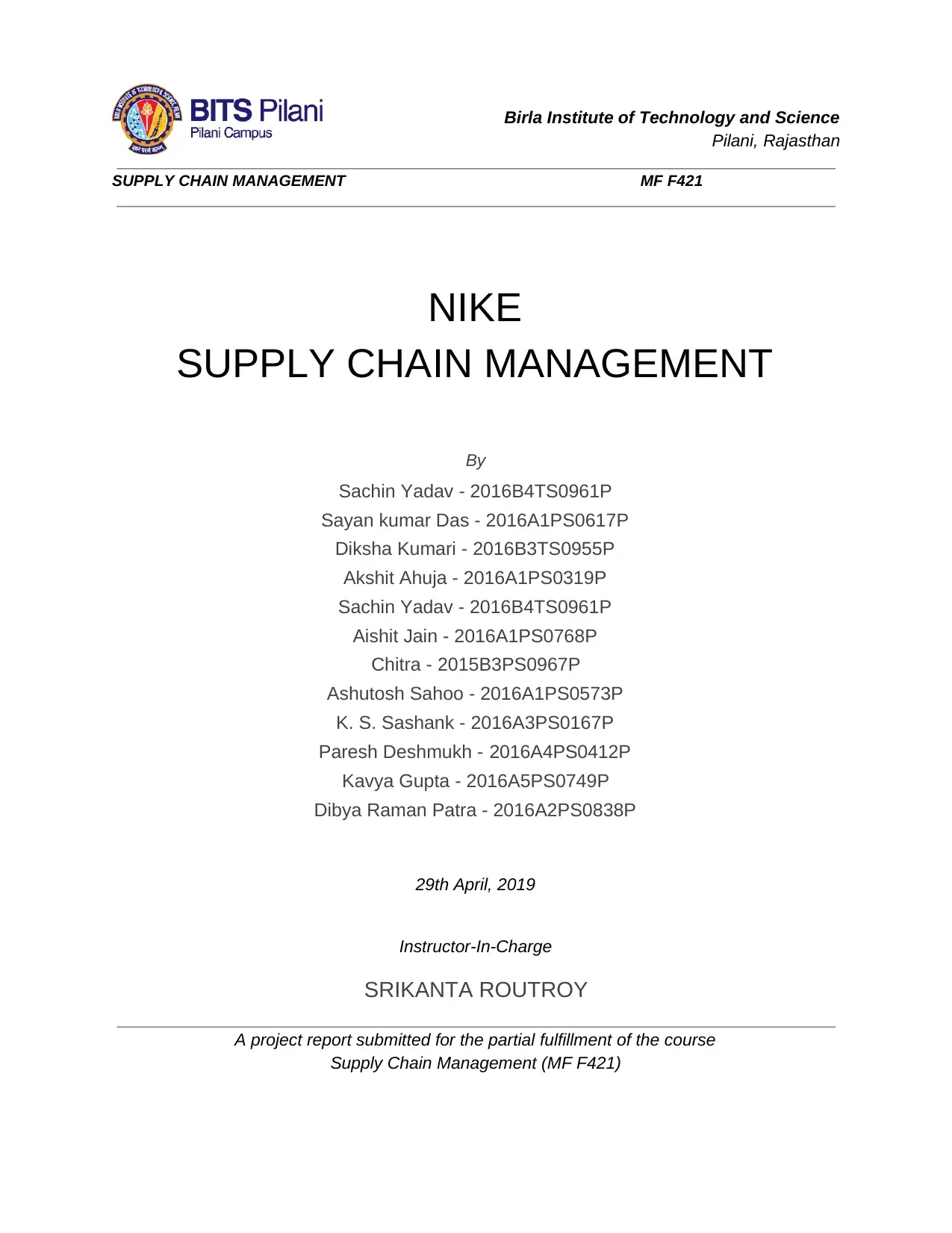
Birla Institute of Technology and Science
Pilani, Rajasthan
SUPPLY CHAIN MANAGEMENT MF F421
NIKE
SUPPLY CHAIN MANAGEMENT
By
Sachin Yadav - 2016B4TS0961P
Sayan kumar Das - 2016A1PS0617P
Diksha Kumari - 2016B3TS0955P
Akshit Ahuja - 2016A1PS0319P
Sachin Yadav - 2016B4TS0961P
Aishit Jain - 2016A1PS0768P
Chitra - 2015B3PS0967P
Ashutosh Sahoo - 2016A1PS0573P
K. S. Sashank - 2016A3PS0167P
Paresh Deshmukh - 2016A4PS0412P
Kavya Gupta - 2016A5PS0749P
Dibya Raman Patra - 2016A2PS0838P
29th April, 2019
Instructor-In-Charge
SRIKANTA ROUTROY
A project report submitted for the partial fulfillment of the course
Supply Chain Management (MF F421)
Pilani, Rajasthan
SUPPLY CHAIN MANAGEMENT MF F421
NIKE
SUPPLY CHAIN MANAGEMENT
By
Sachin Yadav - 2016B4TS0961P
Sayan kumar Das - 2016A1PS0617P
Diksha Kumari - 2016B3TS0955P
Akshit Ahuja - 2016A1PS0319P
Sachin Yadav - 2016B4TS0961P
Aishit Jain - 2016A1PS0768P
Chitra - 2015B3PS0967P
Ashutosh Sahoo - 2016A1PS0573P
K. S. Sashank - 2016A3PS0167P
Paresh Deshmukh - 2016A4PS0412P
Kavya Gupta - 2016A5PS0749P
Dibya Raman Patra - 2016A2PS0838P
29th April, 2019
Instructor-In-Charge
SRIKANTA ROUTROY
A project report submitted for the partial fulfillment of the course
Supply Chain Management (MF F421)
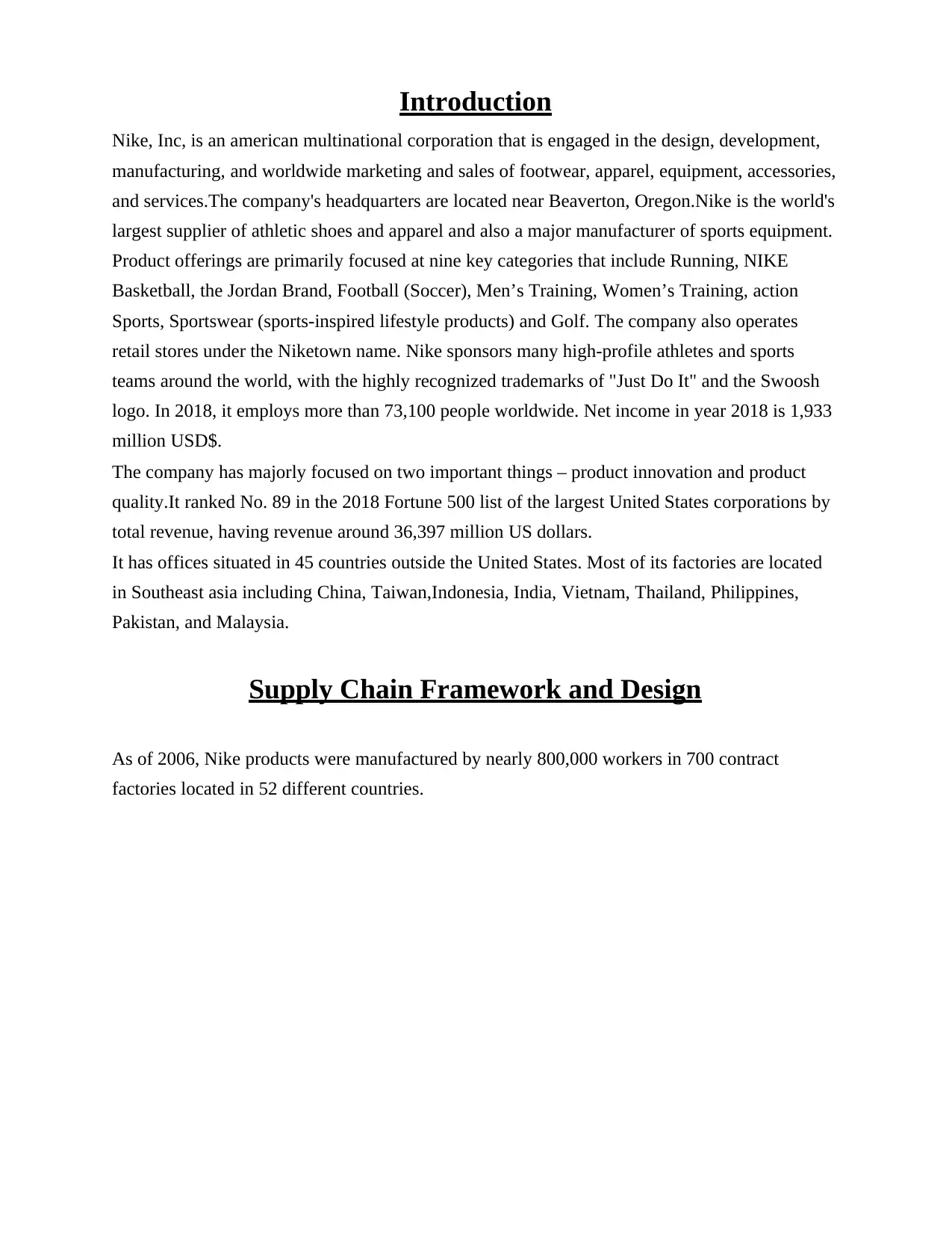
Introduction
Nike, Inc, is an american multinational corporation that is engaged in the design, development,
manufacturing, and worldwide marketing and sales of footwear, apparel, equipment, accessories,
and services.The company's headquarters are located near Beaverton, Oregon.Nike is the world's
largest supplier of athletic shoes and apparel and also a major manufacturer of sports equipment.
Product offerings are primarily focused at nine key categories that include Running, NIKE
Basketball, the Jordan Brand, Football (Soccer), Men’s Training, Women’s Training, action
Sports, Sportswear (sports-inspired lifestyle products) and Golf. The company also operates
retail stores under the Niketown name. Nike sponsors many high-profile athletes and sports
teams around the world, with the highly recognized trademarks of "Just Do It" and the Swoosh
logo. In 2018, it employs more than 73,100 people worldwide. Net income in year 2018 is 1,933
million USD$.
The company has majorly focused on two important things – product innovation and product
quality.It ranked No. 89 in the 2018 Fortune 500 list of the largest United States corporations by
total revenue, having revenue around 36,397 million US dollars.
It has offices situated in 45 countries outside the United States. Most of its factories are located
in Southeast asia including China, Taiwan,Indonesia, India, Vietnam, Thailand, Philippines,
Pakistan, and Malaysia.
Supply Chain Framework and Design
As of 2006, Nike products were manufactured by nearly 800,000 workers in 700 contract
factories located in 52 different countries.
Nike, Inc, is an american multinational corporation that is engaged in the design, development,
manufacturing, and worldwide marketing and sales of footwear, apparel, equipment, accessories,
and services.The company's headquarters are located near Beaverton, Oregon.Nike is the world's
largest supplier of athletic shoes and apparel and also a major manufacturer of sports equipment.
Product offerings are primarily focused at nine key categories that include Running, NIKE
Basketball, the Jordan Brand, Football (Soccer), Men’s Training, Women’s Training, action
Sports, Sportswear (sports-inspired lifestyle products) and Golf. The company also operates
retail stores under the Niketown name. Nike sponsors many high-profile athletes and sports
teams around the world, with the highly recognized trademarks of "Just Do It" and the Swoosh
logo. In 2018, it employs more than 73,100 people worldwide. Net income in year 2018 is 1,933
million USD$.
The company has majorly focused on two important things – product innovation and product
quality.It ranked No. 89 in the 2018 Fortune 500 list of the largest United States corporations by
total revenue, having revenue around 36,397 million US dollars.
It has offices situated in 45 countries outside the United States. Most of its factories are located
in Southeast asia including China, Taiwan,Indonesia, India, Vietnam, Thailand, Philippines,
Pakistan, and Malaysia.
Supply Chain Framework and Design
As of 2006, Nike products were manufactured by nearly 800,000 workers in 700 contract
factories located in 52 different countries.
⊘ This is a preview!⊘
Do you want full access?
Subscribe today to unlock all pages.

Trusted by 1+ million students worldwide
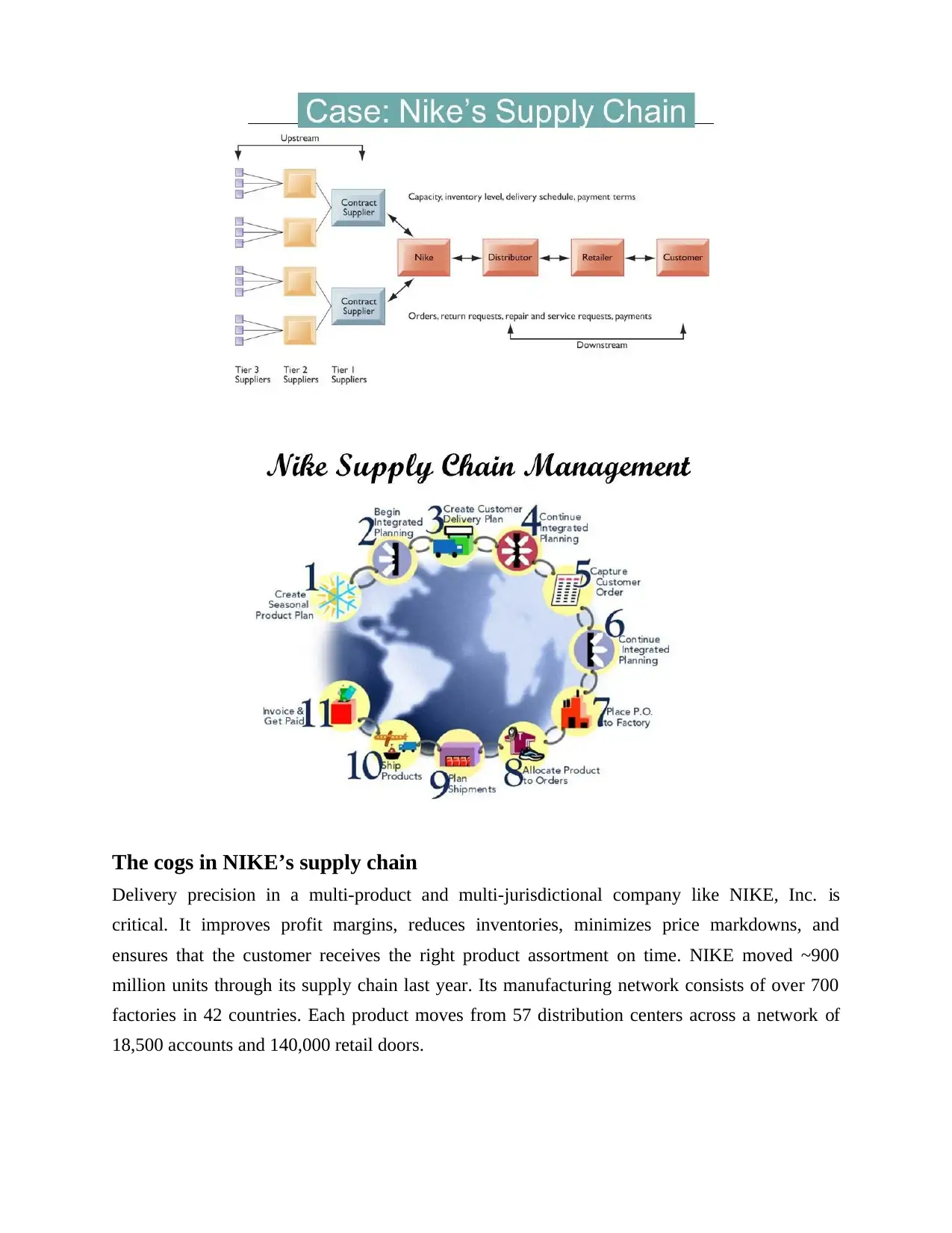
The cogs in NIKE’s supply chain
Delivery precision in a multi-product and multi-jurisdictional company like NIKE, Inc. is
critical. It improves profit margins, reduces inventories, minimizes price markdowns, and
ensures that the customer receives the right product assortment on time. NIKE moved ~900
million units through its supply chain last year. Its manufacturing network consists of over 700
factories in 42 countries. Each product moves from 57 distribution centers across a network of
18,500 accounts and 140,000 retail doors.
Delivery precision in a multi-product and multi-jurisdictional company like NIKE, Inc. is
critical. It improves profit margins, reduces inventories, minimizes price markdowns, and
ensures that the customer receives the right product assortment on time. NIKE moved ~900
million units through its supply chain last year. Its manufacturing network consists of over 700
factories in 42 countries. Each product moves from 57 distribution centers across a network of
18,500 accounts and 140,000 retail doors.
Paraphrase This Document
Need a fresh take? Get an instant paraphrase of this document with our AI Paraphraser

Yet NIKE owns no factories for manufacturing its footwear and apparel, which make up
~88% of its revenues. Instead, manufacturing is outsourced to third parties because of the cost
advantages of doing so. Most raw materials in NIKE’s supply chain are sourced in the
manufacturing host country by independent contractor
NIKE’s manufacturers
NIKE is one of the pioneers of the industry-defining manufacturing outsourcing strategy. It’s
now exploring innovative ways of manufacturing so it can customize products on an
unprecedented scale.
Key manufacturing thrusts
● Lean manufacturing – By the end of fiscal year 2013, between 70% and 76% of
its apparel and 85% of its footwear products were manufactured on lean lines. This
delivered additional savings of $0.15 per unit through better labor productivity and
lower waste
● Material consolidation – Reducing the number of vendors through which NIKE
sources materials and also reducing the materials used in manufacturing products
● Manufacturing innovation and modernization
Footwear manufacturers
NIKE’s footwear is manufactured outside the US by independent contract manufacturers that
often operate multiple factories. In fiscal year 2014, the company was supplied by ~150 footwear
factories in 14 countries. Contract factories in Vietnam, China, and Indonesia respectively
manufactured approximately 43%, 28%, and 25% of total NIKE’s footwear. The largest single
footwear factory accounted for ~5% of total NIKE brand footwear production.
Apparel manufacturers
~88% of its revenues. Instead, manufacturing is outsourced to third parties because of the cost
advantages of doing so. Most raw materials in NIKE’s supply chain are sourced in the
manufacturing host country by independent contractor
NIKE’s manufacturers
NIKE is one of the pioneers of the industry-defining manufacturing outsourcing strategy. It’s
now exploring innovative ways of manufacturing so it can customize products on an
unprecedented scale.
Key manufacturing thrusts
● Lean manufacturing – By the end of fiscal year 2013, between 70% and 76% of
its apparel and 85% of its footwear products were manufactured on lean lines. This
delivered additional savings of $0.15 per unit through better labor productivity and
lower waste
● Material consolidation – Reducing the number of vendors through which NIKE
sources materials and also reducing the materials used in manufacturing products
● Manufacturing innovation and modernization
Footwear manufacturers
NIKE’s footwear is manufactured outside the US by independent contract manufacturers that
often operate multiple factories. In fiscal year 2014, the company was supplied by ~150 footwear
factories in 14 countries. Contract factories in Vietnam, China, and Indonesia respectively
manufactured approximately 43%, 28%, and 25% of total NIKE’s footwear. The largest single
footwear factory accounted for ~5% of total NIKE brand footwear production.
Apparel manufacturers
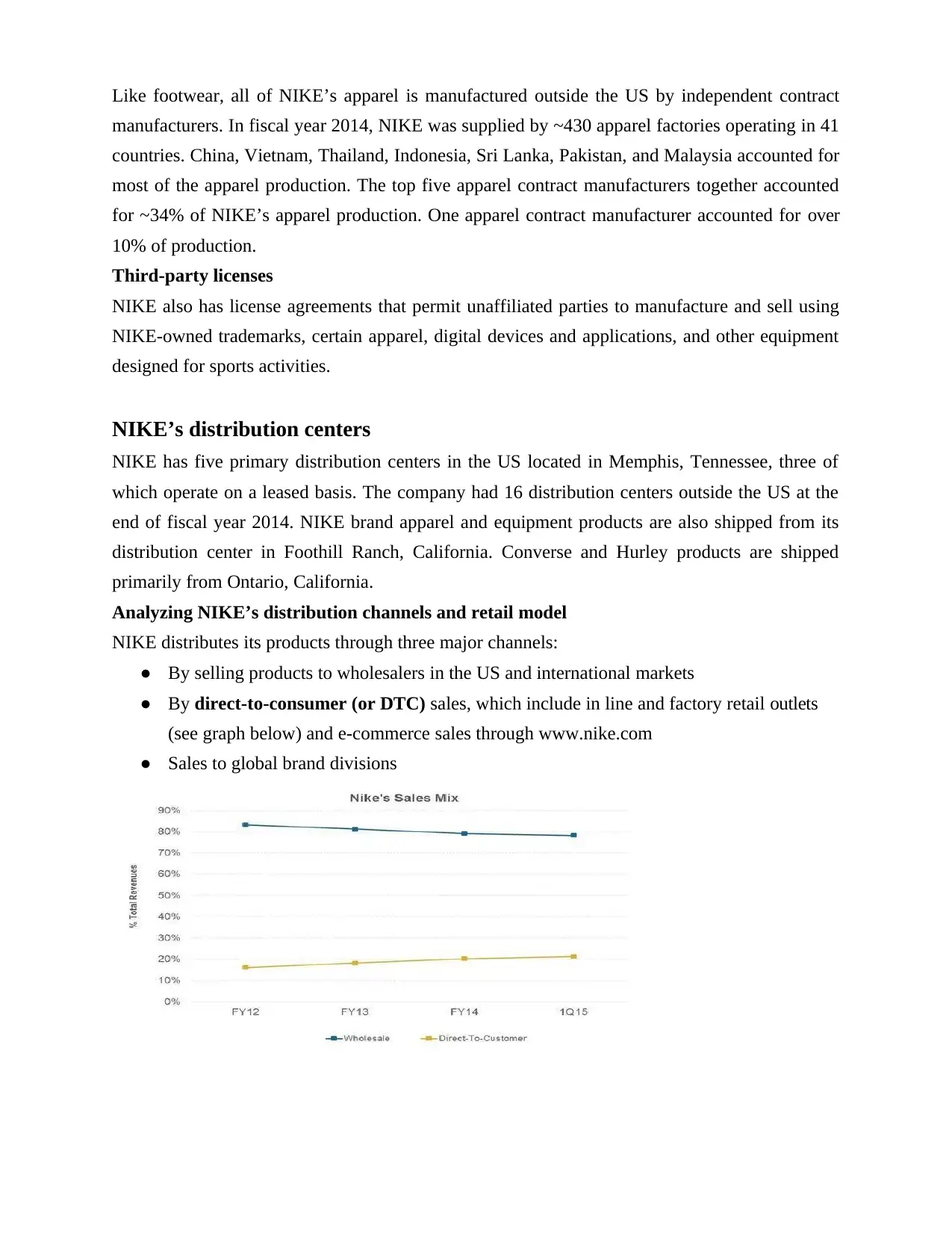
Like footwear, all of NIKE’s apparel is manufactured outside the US by independent contract
manufacturers. In fiscal year 2014, NIKE was supplied by ~430 apparel factories operating in 41
countries. China, Vietnam, Thailand, Indonesia, Sri Lanka, Pakistan, and Malaysia accounted for
most of the apparel production. The top five apparel contract manufacturers together accounted
for ~34% of NIKE’s apparel production. One apparel contract manufacturer accounted for over
10% of production.
Third-party licenses
NIKE also has license agreements that permit unaffiliated parties to manufacture and sell using
NIKE-owned trademarks, certain apparel, digital devices and applications, and other equipment
designed for sports activities.
NIKE’s distribution centers
NIKE has five primary distribution centers in the US located in Memphis, Tennessee, three of
which operate on a leased basis. The company had 16 distribution centers outside the US at the
end of fiscal year 2014. NIKE brand apparel and equipment products are also shipped from its
distribution center in Foothill Ranch, California. Converse and Hurley products are shipped
primarily from Ontario, California.
Analyzing NIKE’s distribution channels and retail model
NIKE distributes its products through three major channels:
● By selling products to wholesalers in the US and international markets
● By direct-to-consumer (or DTC) sales, which include in line and factory retail outlets
(see graph below) and e-commerce sales through www.nike.com
● Sales to global brand divisions
manufacturers. In fiscal year 2014, NIKE was supplied by ~430 apparel factories operating in 41
countries. China, Vietnam, Thailand, Indonesia, Sri Lanka, Pakistan, and Malaysia accounted for
most of the apparel production. The top five apparel contract manufacturers together accounted
for ~34% of NIKE’s apparel production. One apparel contract manufacturer accounted for over
10% of production.
Third-party licenses
NIKE also has license agreements that permit unaffiliated parties to manufacture and sell using
NIKE-owned trademarks, certain apparel, digital devices and applications, and other equipment
designed for sports activities.
NIKE’s distribution centers
NIKE has five primary distribution centers in the US located in Memphis, Tennessee, three of
which operate on a leased basis. The company had 16 distribution centers outside the US at the
end of fiscal year 2014. NIKE brand apparel and equipment products are also shipped from its
distribution center in Foothill Ranch, California. Converse and Hurley products are shipped
primarily from Ontario, California.
Analyzing NIKE’s distribution channels and retail model
NIKE distributes its products through three major channels:
● By selling products to wholesalers in the US and international markets
● By direct-to-consumer (or DTC) sales, which include in line and factory retail outlets
(see graph below) and e-commerce sales through www.nike.com
● Sales to global brand divisions
⊘ This is a preview!⊘
Do you want full access?
Subscribe today to unlock all pages.

Trusted by 1+ million students worldwide
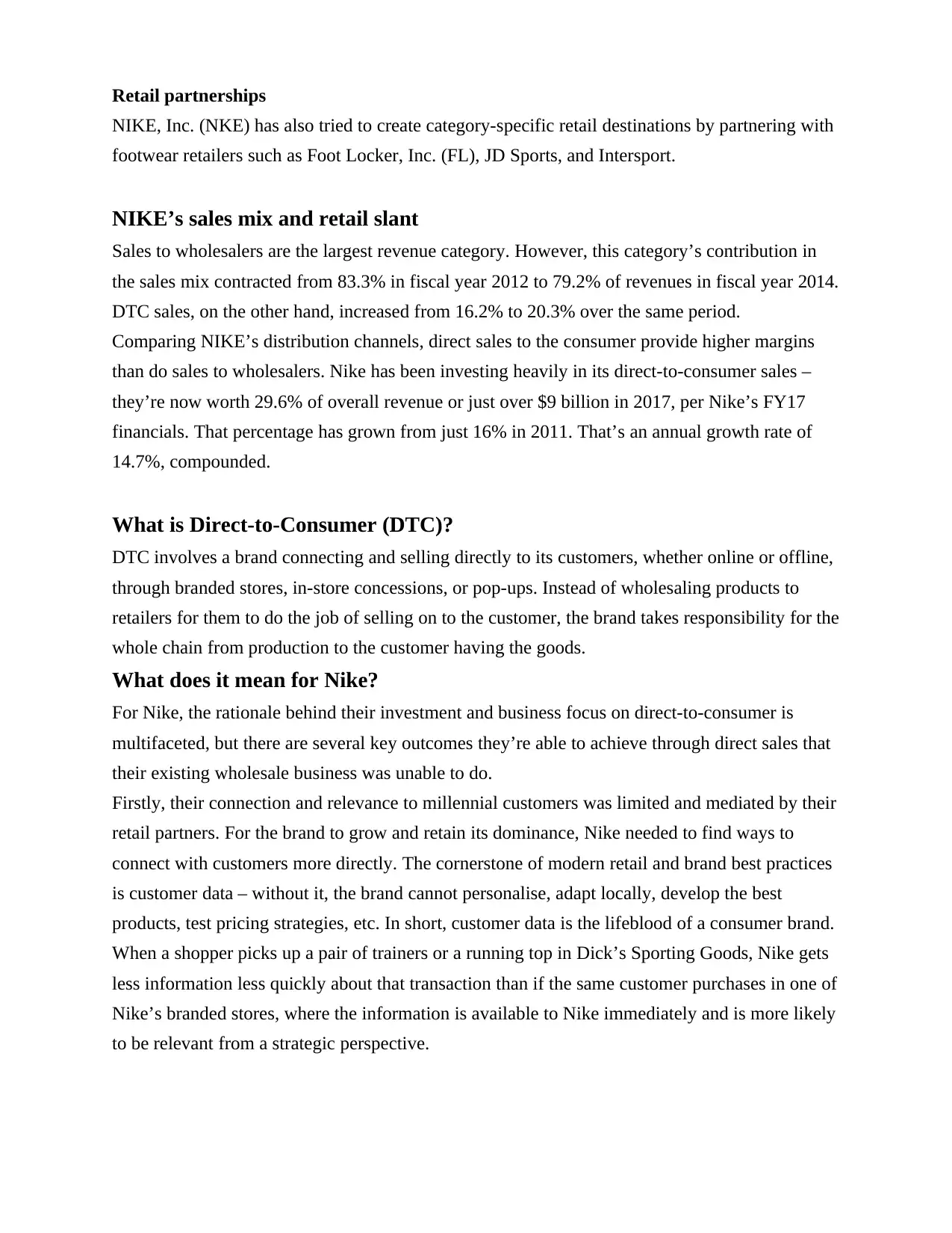
Retail partnerships
NIKE, Inc. (NKE) has also tried to create category-specific retail destinations by partnering with
footwear retailers such as Foot Locker, Inc. (FL), JD Sports, and Intersport.
NIKE’s sales mix and retail slant
Sales to wholesalers are the largest revenue category. However, this category’s contribution in
the sales mix contracted from 83.3% in fiscal year 2012 to 79.2% of revenues in fiscal year 2014.
DTC sales, on the other hand, increased from 16.2% to 20.3% over the same period.
Comparing NIKE’s distribution channels, direct sales to the consumer provide higher margins
than do sales to wholesalers. Nike has been investing heavily in its direct-to-consumer sales –
they’re now worth 29.6% of overall revenue or just over $9 billion in 2017, per Nike’s FY17
financials. That percentage has grown from just 16% in 2011. That’s an annual growth rate of
14.7%, compounded.
What is Direct-to-Consumer (DTC)?
DTC involves a brand connecting and selling directly to its customers, whether online or offline,
through branded stores, in-store concessions, or pop-ups. Instead of wholesaling products to
retailers for them to do the job of selling on to the customer, the brand takes responsibility for the
whole chain from production to the customer having the goods.
What does it mean for Nike?
For Nike, the rationale behind their investment and business focus on direct-to-consumer is
multifaceted, but there are several key outcomes they’re able to achieve through direct sales that
their existing wholesale business was unable to do.
Firstly, their connection and relevance to millennial customers was limited and mediated by their
retail partners. For the brand to grow and retain its dominance, Nike needed to find ways to
connect with customers more directly. The cornerstone of modern retail and brand best practices
is customer data – without it, the brand cannot personalise, adapt locally, develop the best
products, test pricing strategies, etc. In short, customer data is the lifeblood of a consumer brand.
When a shopper picks up a pair of trainers or a running top in Dick’s Sporting Goods, Nike gets
less information less quickly about that transaction than if the same customer purchases in one of
Nike’s branded stores, where the information is available to Nike immediately and is more likely
to be relevant from a strategic perspective.
NIKE, Inc. (NKE) has also tried to create category-specific retail destinations by partnering with
footwear retailers such as Foot Locker, Inc. (FL), JD Sports, and Intersport.
NIKE’s sales mix and retail slant
Sales to wholesalers are the largest revenue category. However, this category’s contribution in
the sales mix contracted from 83.3% in fiscal year 2012 to 79.2% of revenues in fiscal year 2014.
DTC sales, on the other hand, increased from 16.2% to 20.3% over the same period.
Comparing NIKE’s distribution channels, direct sales to the consumer provide higher margins
than do sales to wholesalers. Nike has been investing heavily in its direct-to-consumer sales –
they’re now worth 29.6% of overall revenue or just over $9 billion in 2017, per Nike’s FY17
financials. That percentage has grown from just 16% in 2011. That’s an annual growth rate of
14.7%, compounded.
What is Direct-to-Consumer (DTC)?
DTC involves a brand connecting and selling directly to its customers, whether online or offline,
through branded stores, in-store concessions, or pop-ups. Instead of wholesaling products to
retailers for them to do the job of selling on to the customer, the brand takes responsibility for the
whole chain from production to the customer having the goods.
What does it mean for Nike?
For Nike, the rationale behind their investment and business focus on direct-to-consumer is
multifaceted, but there are several key outcomes they’re able to achieve through direct sales that
their existing wholesale business was unable to do.
Firstly, their connection and relevance to millennial customers was limited and mediated by their
retail partners. For the brand to grow and retain its dominance, Nike needed to find ways to
connect with customers more directly. The cornerstone of modern retail and brand best practices
is customer data – without it, the brand cannot personalise, adapt locally, develop the best
products, test pricing strategies, etc. In short, customer data is the lifeblood of a consumer brand.
When a shopper picks up a pair of trainers or a running top in Dick’s Sporting Goods, Nike gets
less information less quickly about that transaction than if the same customer purchases in one of
Nike’s branded stores, where the information is available to Nike immediately and is more likely
to be relevant from a strategic perspective.
Paraphrase This Document
Need a fresh take? Get an instant paraphrase of this document with our AI Paraphraser
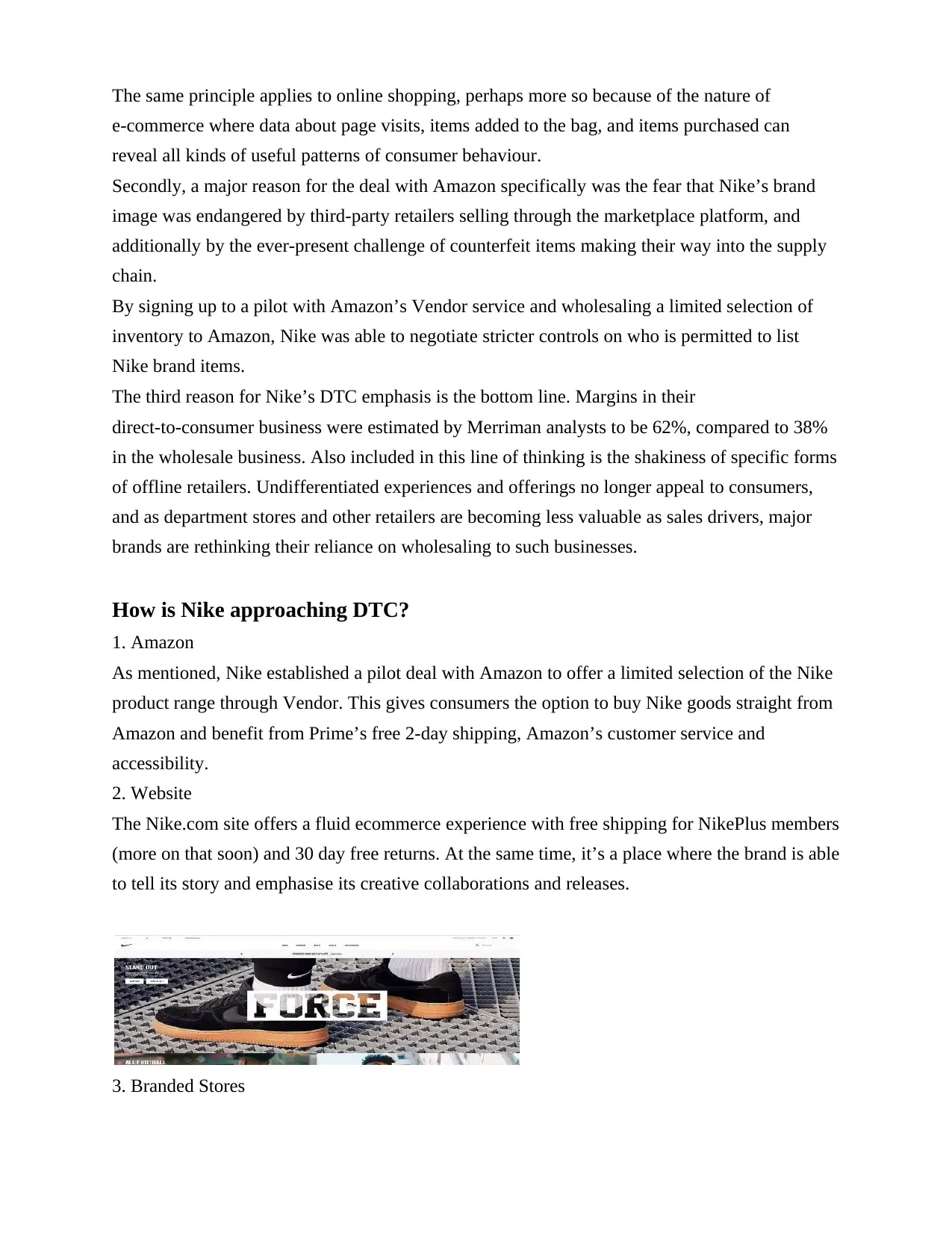
The same principle applies to online shopping, perhaps more so because of the nature of
e-commerce where data about page visits, items added to the bag, and items purchased can
reveal all kinds of useful patterns of consumer behaviour.
Secondly, a major reason for the deal with Amazon specifically was the fear that Nike’s brand
image was endangered by third-party retailers selling through the marketplace platform, and
additionally by the ever-present challenge of counterfeit items making their way into the supply
chain.
By signing up to a pilot with Amazon’s Vendor service and wholesaling a limited selection of
inventory to Amazon, Nike was able to negotiate stricter controls on who is permitted to list
Nike brand items.
The third reason for Nike’s DTC emphasis is the bottom line. Margins in their
direct-to-consumer business were estimated by Merriman analysts to be 62%, compared to 38%
in the wholesale business. Also included in this line of thinking is the shakiness of specific forms
of offline retailers. Undifferentiated experiences and offerings no longer appeal to consumers,
and as department stores and other retailers are becoming less valuable as sales drivers, major
brands are rethinking their reliance on wholesaling to such businesses.
How is Nike approaching DTC?
1. Amazon
As mentioned, Nike established a pilot deal with Amazon to offer a limited selection of the Nike
product range through Vendor. This gives consumers the option to buy Nike goods straight from
Amazon and benefit from Prime’s free 2-day shipping, Amazon’s customer service and
accessibility.
2. Website
The Nike.com site offers a fluid ecommerce experience with free shipping for NikePlus members
(more on that soon) and 30 day free returns. At the same time, it’s a place where the brand is able
to tell its story and emphasise its creative collaborations and releases.
3. Branded Stores
e-commerce where data about page visits, items added to the bag, and items purchased can
reveal all kinds of useful patterns of consumer behaviour.
Secondly, a major reason for the deal with Amazon specifically was the fear that Nike’s brand
image was endangered by third-party retailers selling through the marketplace platform, and
additionally by the ever-present challenge of counterfeit items making their way into the supply
chain.
By signing up to a pilot with Amazon’s Vendor service and wholesaling a limited selection of
inventory to Amazon, Nike was able to negotiate stricter controls on who is permitted to list
Nike brand items.
The third reason for Nike’s DTC emphasis is the bottom line. Margins in their
direct-to-consumer business were estimated by Merriman analysts to be 62%, compared to 38%
in the wholesale business. Also included in this line of thinking is the shakiness of specific forms
of offline retailers. Undifferentiated experiences and offerings no longer appeal to consumers,
and as department stores and other retailers are becoming less valuable as sales drivers, major
brands are rethinking their reliance on wholesaling to such businesses.
How is Nike approaching DTC?
1. Amazon
As mentioned, Nike established a pilot deal with Amazon to offer a limited selection of the Nike
product range through Vendor. This gives consumers the option to buy Nike goods straight from
Amazon and benefit from Prime’s free 2-day shipping, Amazon’s customer service and
accessibility.
2. Website
The Nike.com site offers a fluid ecommerce experience with free shipping for NikePlus members
(more on that soon) and 30 day free returns. At the same time, it’s a place where the brand is able
to tell its story and emphasise its creative collaborations and releases.
3. Branded Stores
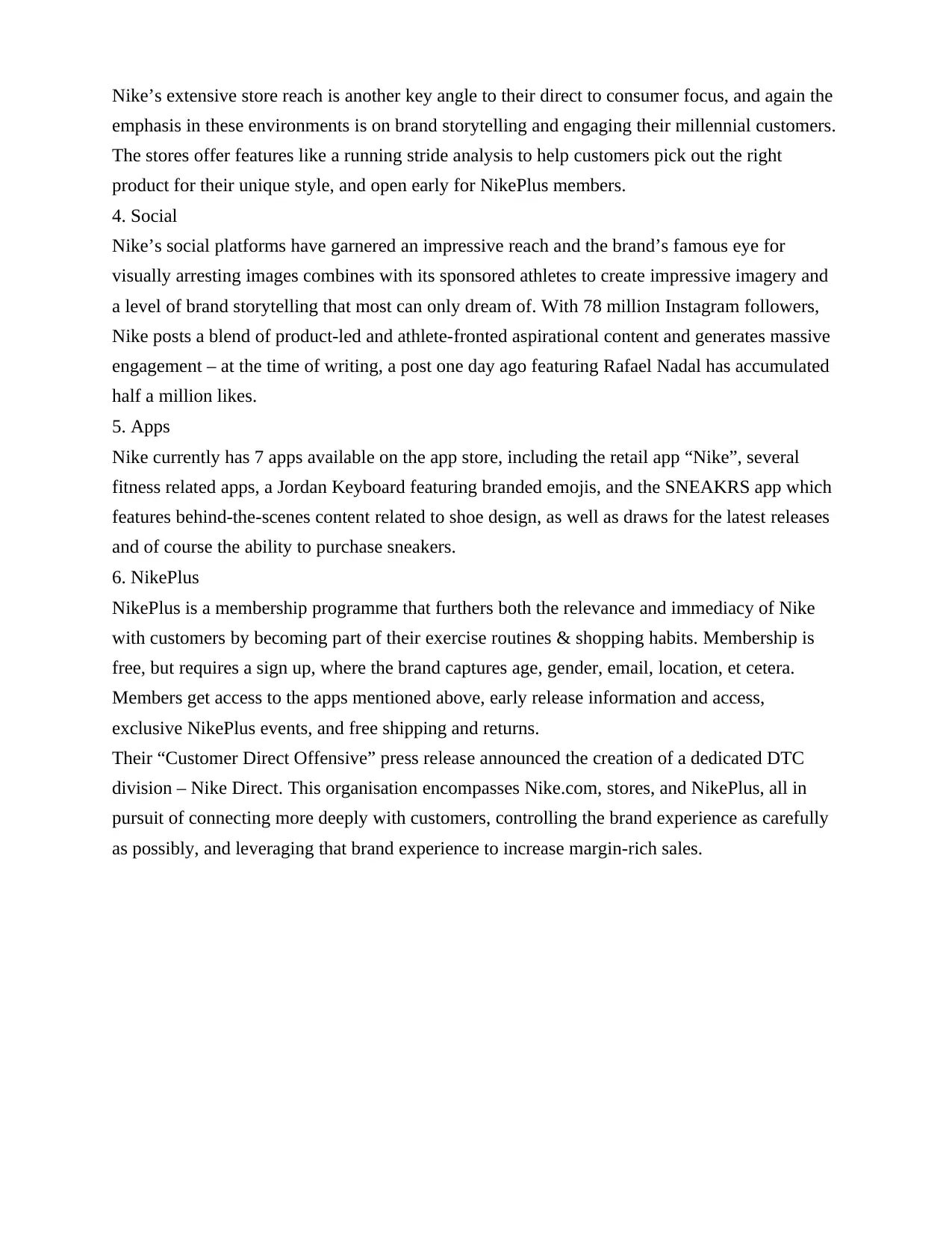
Nike’s extensive store reach is another key angle to their direct to consumer focus, and again the
emphasis in these environments is on brand storytelling and engaging their millennial customers.
The stores offer features like a running stride analysis to help customers pick out the right
product for their unique style, and open early for NikePlus members.
4. Social
Nike’s social platforms have garnered an impressive reach and the brand’s famous eye for
visually arresting images combines with its sponsored athletes to create impressive imagery and
a level of brand storytelling that most can only dream of. With 78 million Instagram followers,
Nike posts a blend of product-led and athlete-fronted aspirational content and generates massive
engagement – at the time of writing, a post one day ago featuring Rafael Nadal has accumulated
half a million likes.
5. Apps
Nike currently has 7 apps available on the app store, including the retail app “Nike”, several
fitness related apps, a Jordan Keyboard featuring branded emojis, and the SNEAKRS app which
features behind-the-scenes content related to shoe design, as well as draws for the latest releases
and of course the ability to purchase sneakers.
6. NikePlus
NikePlus is a membership programme that furthers both the relevance and immediacy of Nike
with customers by becoming part of their exercise routines & shopping habits. Membership is
free, but requires a sign up, where the brand captures age, gender, email, location, et cetera.
Members get access to the apps mentioned above, early release information and access,
exclusive NikePlus events, and free shipping and returns.
Their “Customer Direct Offensive” press release announced the creation of a dedicated DTC
division – Nike Direct. This organisation encompasses Nike.com, stores, and NikePlus, all in
pursuit of connecting more deeply with customers, controlling the brand experience as carefully
as possibly, and leveraging that brand experience to increase margin-rich sales.
emphasis in these environments is on brand storytelling and engaging their millennial customers.
The stores offer features like a running stride analysis to help customers pick out the right
product for their unique style, and open early for NikePlus members.
4. Social
Nike’s social platforms have garnered an impressive reach and the brand’s famous eye for
visually arresting images combines with its sponsored athletes to create impressive imagery and
a level of brand storytelling that most can only dream of. With 78 million Instagram followers,
Nike posts a blend of product-led and athlete-fronted aspirational content and generates massive
engagement – at the time of writing, a post one day ago featuring Rafael Nadal has accumulated
half a million likes.
5. Apps
Nike currently has 7 apps available on the app store, including the retail app “Nike”, several
fitness related apps, a Jordan Keyboard featuring branded emojis, and the SNEAKRS app which
features behind-the-scenes content related to shoe design, as well as draws for the latest releases
and of course the ability to purchase sneakers.
6. NikePlus
NikePlus is a membership programme that furthers both the relevance and immediacy of Nike
with customers by becoming part of their exercise routines & shopping habits. Membership is
free, but requires a sign up, where the brand captures age, gender, email, location, et cetera.
Members get access to the apps mentioned above, early release information and access,
exclusive NikePlus events, and free shipping and returns.
Their “Customer Direct Offensive” press release announced the creation of a dedicated DTC
division – Nike Direct. This organisation encompasses Nike.com, stores, and NikePlus, all in
pursuit of connecting more deeply with customers, controlling the brand experience as carefully
as possibly, and leveraging that brand experience to increase margin-rich sales.
⊘ This is a preview!⊘
Do you want full access?
Subscribe today to unlock all pages.

Trusted by 1+ million students worldwide
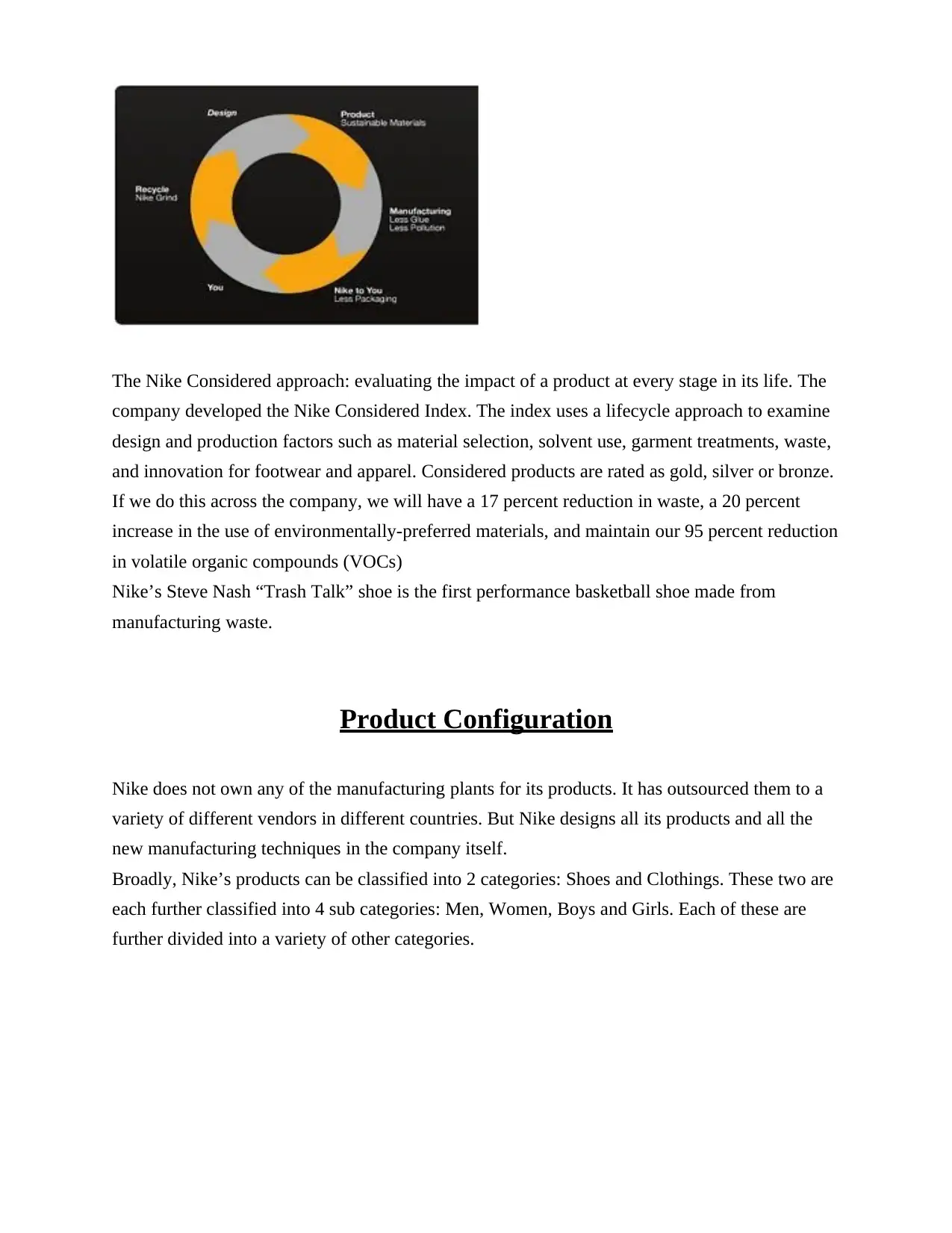
The Nike Considered approach: evaluating the impact of a product at every stage in its life. The
company developed the Nike Considered Index. The index uses a lifecycle approach to examine
design and production factors such as material selection, solvent use, garment treatments, waste,
and innovation for footwear and apparel. Considered products are rated as gold, silver or bronze.
If we do this across the company, we will have a 17 percent reduction in waste, a 20 percent
increase in the use of environmentally-preferred materials, and maintain our 95 percent reduction
in volatile organic compounds (VOCs)
Nike’s Steve Nash “Trash Talk” shoe is the first performance basketball shoe made from
manufacturing waste.
Product Configuration
Nike does not own any of the manufacturing plants for its products. It has outsourced them to a
variety of different vendors in different countries. But Nike designs all its products and all the
new manufacturing techniques in the company itself.
Broadly, Nike’s products can be classified into 2 categories: Shoes and Clothings. These two are
each further classified into 4 sub categories: Men, Women, Boys and Girls. Each of these are
further divided into a variety of other categories.
company developed the Nike Considered Index. The index uses a lifecycle approach to examine
design and production factors such as material selection, solvent use, garment treatments, waste,
and innovation for footwear and apparel. Considered products are rated as gold, silver or bronze.
If we do this across the company, we will have a 17 percent reduction in waste, a 20 percent
increase in the use of environmentally-preferred materials, and maintain our 95 percent reduction
in volatile organic compounds (VOCs)
Nike’s Steve Nash “Trash Talk” shoe is the first performance basketball shoe made from
manufacturing waste.
Product Configuration
Nike does not own any of the manufacturing plants for its products. It has outsourced them to a
variety of different vendors in different countries. But Nike designs all its products and all the
new manufacturing techniques in the company itself.
Broadly, Nike’s products can be classified into 2 categories: Shoes and Clothings. These two are
each further classified into 4 sub categories: Men, Women, Boys and Girls. Each of these are
further divided into a variety of other categories.
Paraphrase This Document
Need a fresh take? Get an instant paraphrase of this document with our AI Paraphraser
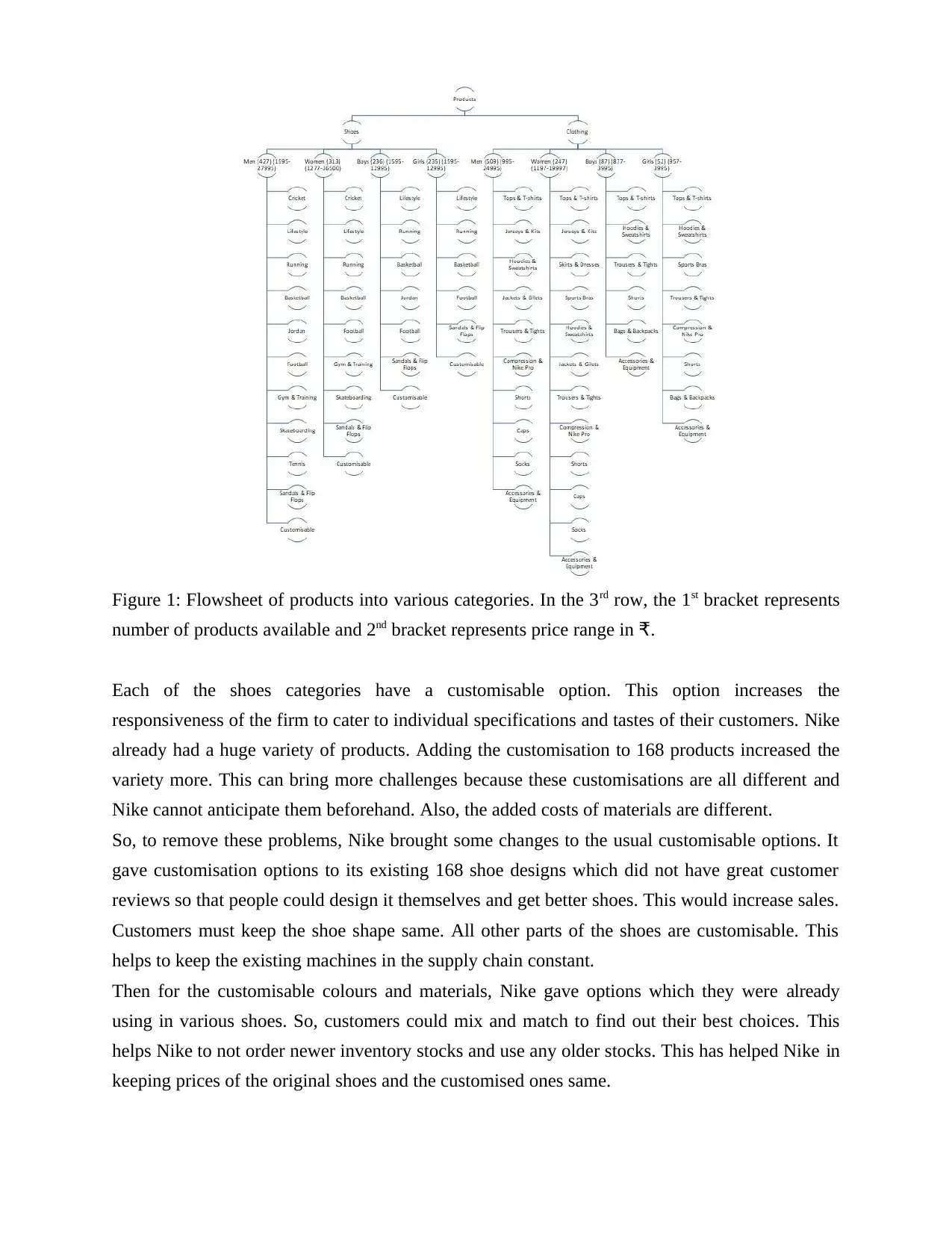
Figure 1: Flowsheet of products into various categories. In the 3rd row, the 1st bracket represents
number of products available and 2nd bracket represents price range in ₹.
Each of the shoes categories have a customisable option. This option increases the
responsiveness of the firm to cater to individual specifications and tastes of their customers. Nike
already had a huge variety of products. Adding the customisation to 168 products increased the
variety more. This can bring more challenges because these customisations are all different and
Nike cannot anticipate them beforehand. Also, the added costs of materials are different.
So, to remove these problems, Nike brought some changes to the usual customisable options. It
gave customisation options to its existing 168 shoe designs which did not have great customer
reviews so that people could design it themselves and get better shoes. This would increase sales.
Customers must keep the shoe shape same. All other parts of the shoes are customisable. This
helps to keep the existing machines in the supply chain constant.
Then for the customisable colours and materials, Nike gave options which they were already
using in various shoes. So, customers could mix and match to find out their best choices. This
helps Nike to not order newer inventory stocks and use any older stocks. This has helped Nike in
keeping prices of the original shoes and the customised ones same.
number of products available and 2nd bracket represents price range in ₹.
Each of the shoes categories have a customisable option. This option increases the
responsiveness of the firm to cater to individual specifications and tastes of their customers. Nike
already had a huge variety of products. Adding the customisation to 168 products increased the
variety more. This can bring more challenges because these customisations are all different and
Nike cannot anticipate them beforehand. Also, the added costs of materials are different.
So, to remove these problems, Nike brought some changes to the usual customisable options. It
gave customisation options to its existing 168 shoe designs which did not have great customer
reviews so that people could design it themselves and get better shoes. This would increase sales.
Customers must keep the shoe shape same. All other parts of the shoes are customisable. This
helps to keep the existing machines in the supply chain constant.
Then for the customisable colours and materials, Nike gave options which they were already
using in various shoes. So, customers could mix and match to find out their best choices. This
helps Nike to not order newer inventory stocks and use any older stocks. This has helped Nike in
keeping prices of the original shoes and the customised ones same.
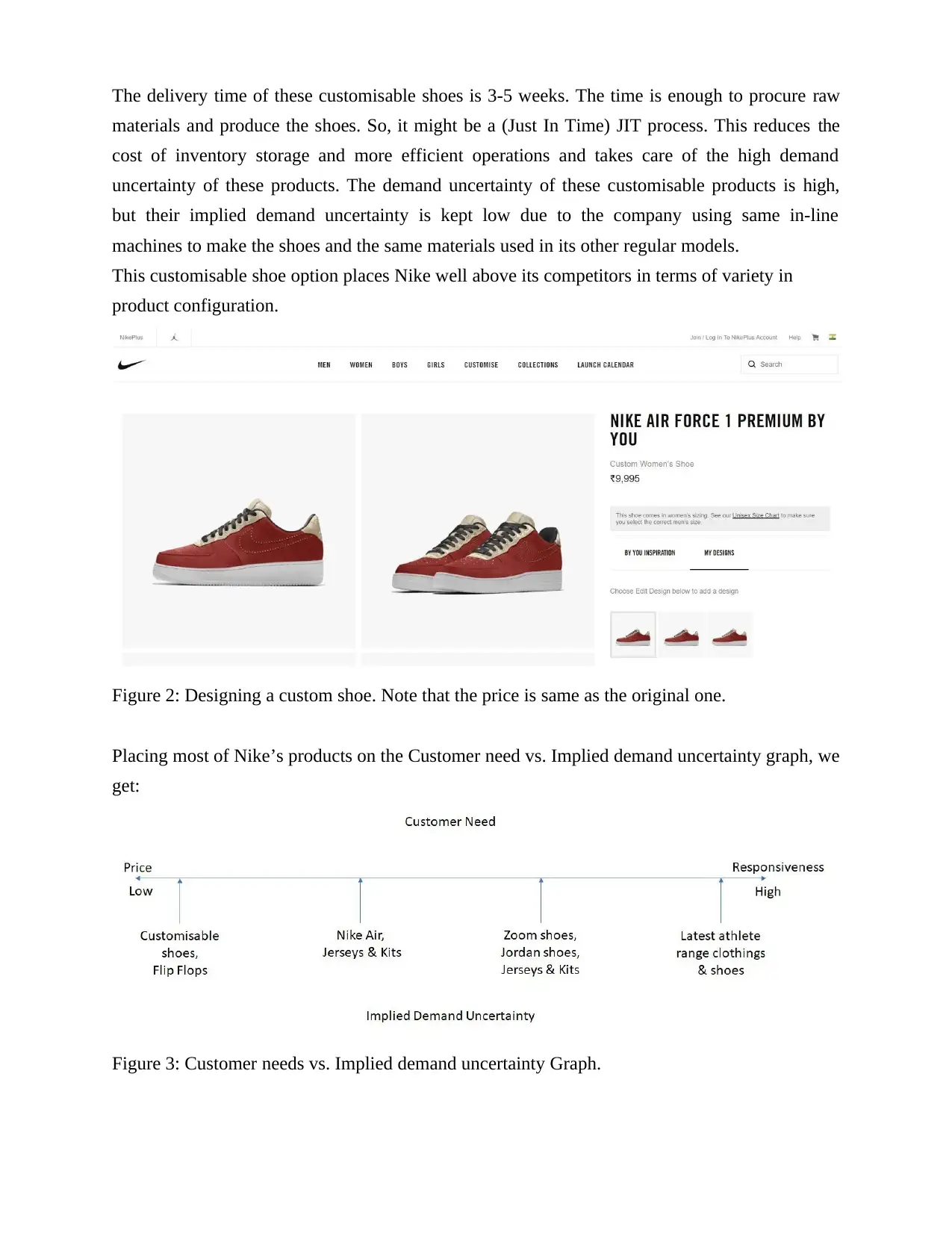
The delivery time of these customisable shoes is 3-5 weeks. The time is enough to procure raw
materials and produce the shoes. So, it might be a (Just In Time) JIT process. This reduces the
cost of inventory storage and more efficient operations and takes care of the high demand
uncertainty of these products. The demand uncertainty of these customisable products is high,
but their implied demand uncertainty is kept low due to the company using same in-line
machines to make the shoes and the same materials used in its other regular models.
This customisable shoe option places Nike well above its competitors in terms of variety in
product configuration.
Figure 2: Designing a custom shoe. Note that the price is same as the original one.
Placing most of Nike’s products on the Customer need vs. Implied demand uncertainty graph, we
get:
Figure 3: Customer needs vs. Implied demand uncertainty Graph.
materials and produce the shoes. So, it might be a (Just In Time) JIT process. This reduces the
cost of inventory storage and more efficient operations and takes care of the high demand
uncertainty of these products. The demand uncertainty of these customisable products is high,
but their implied demand uncertainty is kept low due to the company using same in-line
machines to make the shoes and the same materials used in its other regular models.
This customisable shoe option places Nike well above its competitors in terms of variety in
product configuration.
Figure 2: Designing a custom shoe. Note that the price is same as the original one.
Placing most of Nike’s products on the Customer need vs. Implied demand uncertainty graph, we
get:
Figure 3: Customer needs vs. Implied demand uncertainty Graph.
⊘ This is a preview!⊘
Do you want full access?
Subscribe today to unlock all pages.

Trusted by 1+ million students worldwide
1 out of 40
Your All-in-One AI-Powered Toolkit for Academic Success.
+13062052269
info@desklib.com
Available 24*7 on WhatsApp / Email
![[object Object]](/_next/static/media/star-bottom.7253800d.svg)
Unlock your academic potential
Copyright © 2020–2025 A2Z Services. All Rights Reserved. Developed and managed by ZUCOL.